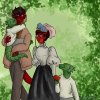laceanddoodles
Your run of the mill Victorian lady
Nobody ever seems to use the character theory prefix, and I really don’t know why. Anyway. It is past midnight, and I can’t stop thinking about , well, a bunch of esoteric character design and development nonsense.
If you’ve interacted with me in any capacity on this site, there’s a pretty high chance you’ll have figured out at least one of these two things: I’m a creative writing student, and I really like history, especially historical fashion. Both of these things majorly play into how I go about designing and developing my characters, and it got me thinking.
I tend to go real in depth into how my character dresses, and why they choose to dress that way, as an in to the character. Take one of my current D&D characters, Celestine— the world of her campaign is Victorian inspired, and she is a fashionable, noble born, socialite. She is also a red tiefling in a vehemently anti-magic society rife with religious based oppression. If it weren’t for her parents’ status and respectability, she would be on the bottom of society. On top of that, while her family is nobility and well respected, they’re kinda hurting for money. So she dresses accordingly.
All of her outfits are chosen very deliberately and with great care. Her wardrobe is constructed of pieces that deemphasize the color of her skin, minimizing the redness as much as possible. She wears hats whenever it is appropriate for a lady of her status to do so, and gloves. Her dresses are cut fashionably, but without a lot of lace and frill. She prefers pieces that are deceptively simple, but incredibly well made, perfectly fitted, and meticulously kept up. She, like any good little Victorian lady, is quite comfortable mending and farming and keeping up with her clothes so as to get as much wear out of them as physically possible before having to buy new ones.

(Celestine, pictured here with party-mate Asthir and two child NPCs, sporting a sweater modeled after real examples from the 1890s and a simple walking skirt. Practical, elegant, and fashionable.)
And I go through this sort of process with all of my characters, analyzing why they dress the way they do and what that says about them as a character.
So! What are some of the more odd questions that you ask yourself when making a new character? What sorts of things do you consider, and in what ways, if any, do the physical character and costume design, end up affecting how you develop them?
Also, why do your characters dress the way they do? Just for fun.
If you’ve interacted with me in any capacity on this site, there’s a pretty high chance you’ll have figured out at least one of these two things: I’m a creative writing student, and I really like history, especially historical fashion. Both of these things majorly play into how I go about designing and developing my characters, and it got me thinking.
I tend to go real in depth into how my character dresses, and why they choose to dress that way, as an in to the character. Take one of my current D&D characters, Celestine— the world of her campaign is Victorian inspired, and she is a fashionable, noble born, socialite. She is also a red tiefling in a vehemently anti-magic society rife with religious based oppression. If it weren’t for her parents’ status and respectability, she would be on the bottom of society. On top of that, while her family is nobility and well respected, they’re kinda hurting for money. So she dresses accordingly.
All of her outfits are chosen very deliberately and with great care. Her wardrobe is constructed of pieces that deemphasize the color of her skin, minimizing the redness as much as possible. She wears hats whenever it is appropriate for a lady of her status to do so, and gloves. Her dresses are cut fashionably, but without a lot of lace and frill. She prefers pieces that are deceptively simple, but incredibly well made, perfectly fitted, and meticulously kept up. She, like any good little Victorian lady, is quite comfortable mending and farming and keeping up with her clothes so as to get as much wear out of them as physically possible before having to buy new ones.

(Celestine, pictured here with party-mate Asthir and two child NPCs, sporting a sweater modeled after real examples from the 1890s and a simple walking skirt. Practical, elegant, and fashionable.)
And I go through this sort of process with all of my characters, analyzing why they dress the way they do and what that says about them as a character.
So! What are some of the more odd questions that you ask yourself when making a new character? What sorts of things do you consider, and in what ways, if any, do the physical character and costume design, end up affecting how you develop them?
Also, why do your characters dress the way they do? Just for fun.

